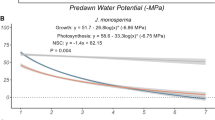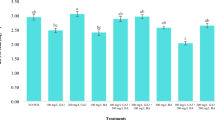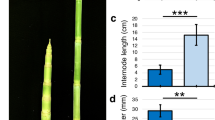Abstract
De Haan and van Aggelen-Bot1 reported that the amount of rubber per seedling (Hevea brasiliensis), in daylight, varied with the dry weight of the plant and that the amount of rubber did not diminish when the plant was kept in the dark. These findings have never been confirmed, and Teas2 has recently suggested that rubber might be regarded as a food reserve in Hevea. Spence and McCallum3 concluded that rubber acted as a food reserve in guayule (Parthenium argentatum); but Bonner and Galston4 were unable to confirm this conclusion. If rubber can be regarded as a food reserve, its concentration in the tissues should, presumably, be affected by changes in mineral status which influence carbohydrate formation. This assumption may be partially correct as it has been shown5, for Hevea, that nutrient deficiencies may cause a diminution in the rubber concentration of stems and petioles in the earlier stages of growth, before the deficiency became sufficiently acute to cause a severe reduction in the total dry weight of the plant. This communication shows that the rubber contained in Hevea seedlings varied according to the dry weight of the plant and to the amounts of total carbohydrate and protein present, whether in the dark or in light, and in so far as these latter substrates were influenced by mineral status so also was the amount of rubber produced by the plant. However, these findings did not prove that rubber acted as a food reserve in Hevea as, under the ‘dark’ conditions of our experiment, severe starvation did not occur.
This is a preview of subscription content, access via your institution
Access options
Subscribe to this journal
Receive 51 print issues and online access
$199.00 per year
only $3.90 per issue
Buy this article
- Purchase on Springer Link
- Instant access to full article PDF
Prices may be subject to local taxes which are calculated during checkout
Similar content being viewed by others
References
de Haan, I., and van Aggelen-Bot, G. M., Arch. Rubbercult., 26, 121 (1949).
Teas, H. J., “Physiology of Rubber Formation in Hevea”, Final Report, 1953–1956, Tobacco and Special Crops Section, U.S. Dept. of Agriculture (1956).
Spence, D., and McCallum, W. J., I.R.I. Trans., 11, 119 (1935).
Bonner, J., and Galston, A. W., Bot. Rev., 13, 543 (1947).
Bolle-Jones, E. W., Nature, 173, 690 (1954).
Author information
Authors and Affiliations
Rights and permissions
About this article
Cite this article
BOLLE-JONES, E., MALLIKARJUNNESWARA, V. Rubber Formation in Hevea brasiliensis as affected by Light and Mineral Status. Nature 179, 1199–1200 (1957). https://doi.org/10.1038/1791199a0
Issue Date:
DOI: https://doi.org/10.1038/1791199a0
Comments
By submitting a comment you agree to abide by our Terms and Community Guidelines. If you find something abusive or that does not comply with our terms or guidelines please flag it as inappropriate.



